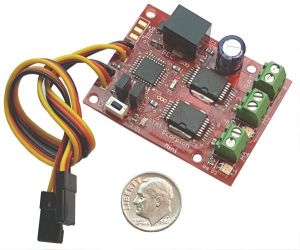Difference between revisions of "ESCs"
(Bit of a brain dump for now) |
|||
| Line 1: | Line 1: | ||
| − | + | '''Electronic Speed Controllers''', or '''ESCs''', are circuits that let you control motor speed and direction remotely, using a signal from the radio receiver. One circuit board may have one or more independent motor controllers, and some small ESCs are integrated with a receiver to minimize size and weight for small bots. | |
| − | + | ||
[[File:Scorpion_Mini.jpg|thumb|Scorpion Mini ESC by RobotPower]] | [[File:Scorpion_Mini.jpg|thumb|Scorpion Mini ESC by RobotPower]] | ||
| − | Brushed | + | =How ESCs work= |
| + | An ESC plugs into the receiver. It changes the pulses that would have moved a servo, and makes them into a variable motor voltage instead. ESCs have a connection to draw power from the battery, and another to attach to the motor(s). | ||
| + | |||
| + | There are two completely different types. | ||
| + | *'''Regular, or Brushed ESCs''' only drive brushed DC motors. | ||
| + | *'''Brushless ESCs''' only drive brushless motors. | ||
| + | |||
| + | Most ESCs are built around small computer chips, and often have programmable settings including "battery saver" low-voltage cutoff, and channel mixing for single-stick operation using even the simplest radio transmitters. | ||
| + | |||
| + | =Selecting an ESC= | ||
| + | Note: It is most convenient by far to choose ESCs that are specifically sold for use in combat robotics. A wide range of other ESCs are available for model hobby purposes, but you must select carefully. | ||
| + | |||
| + | ESCs may be judged by: | ||
| + | *'''Voltage''' of the battery (and by extension, the motors). Never operate an ESC on a voltage greater than its highest rating. | ||
| + | *'''Current''', which along with voltage determines how much power can be delivered to the motors. An ESCs should never be rated lower than the stall current of the motor(s) connected to it. | ||
| + | *'''Cooling''', since combat robotics is extremely demanding on its circuits even though most matches are only a few minutes long. An underrated ESC will stop working or burn out if it is driven beyond its capacity to stay cool. | ||
| − | + | If you are using the ESC to operate any motor that has to spin both ways (drive wheels, for example), the ESC must be “reversible” — that is, capable of bidirectional operation. (In some cases it may be possible to reflash the firmware on an ESC to make it bidirectional.) | |
| + | *"Car and truck" ESCs have reversing ability. | ||
| + | *"Airplane" ESCs designed for flight are often intended to spin a propeller one way, and may not be able to reverse the motor without a firmware flash. To save weight, airplane ESCs may also have smaller, lighter heat sinks intended for air cooled operation. | ||
| + | *ESCs for "Boat" duty also may not reverse, and some are designed to be water cooled and have no heat sink at all. | ||
Revision as of 05:43, 25 May 2021
Electronic Speed Controllers, or ESCs, are circuits that let you control motor speed and direction remotely, using a signal from the radio receiver. One circuit board may have one or more independent motor controllers, and some small ESCs are integrated with a receiver to minimize size and weight for small bots.
How ESCs work
An ESC plugs into the receiver. It changes the pulses that would have moved a servo, and makes them into a variable motor voltage instead. ESCs have a connection to draw power from the battery, and another to attach to the motor(s).
There are two completely different types.
- Regular, or Brushed ESCs only drive brushed DC motors.
- Brushless ESCs only drive brushless motors.
Most ESCs are built around small computer chips, and often have programmable settings including "battery saver" low-voltage cutoff, and channel mixing for single-stick operation using even the simplest radio transmitters.
Selecting an ESC
Note: It is most convenient by far to choose ESCs that are specifically sold for use in combat robotics. A wide range of other ESCs are available for model hobby purposes, but you must select carefully.
ESCs may be judged by:
- Voltage of the battery (and by extension, the motors). Never operate an ESC on a voltage greater than its highest rating.
- Current, which along with voltage determines how much power can be delivered to the motors. An ESCs should never be rated lower than the stall current of the motor(s) connected to it.
- Cooling, since combat robotics is extremely demanding on its circuits even though most matches are only a few minutes long. An underrated ESC will stop working or burn out if it is driven beyond its capacity to stay cool.
If you are using the ESC to operate any motor that has to spin both ways (drive wheels, for example), the ESC must be “reversible” — that is, capable of bidirectional operation. (In some cases it may be possible to reflash the firmware on an ESC to make it bidirectional.)
- "Car and truck" ESCs have reversing ability.
- "Airplane" ESCs designed for flight are often intended to spin a propeller one way, and may not be able to reverse the motor without a firmware flash. To save weight, airplane ESCs may also have smaller, lighter heat sinks intended for air cooled operation.
- ESCs for "Boat" duty also may not reverse, and some are designed to be water cooled and have no heat sink at all.
